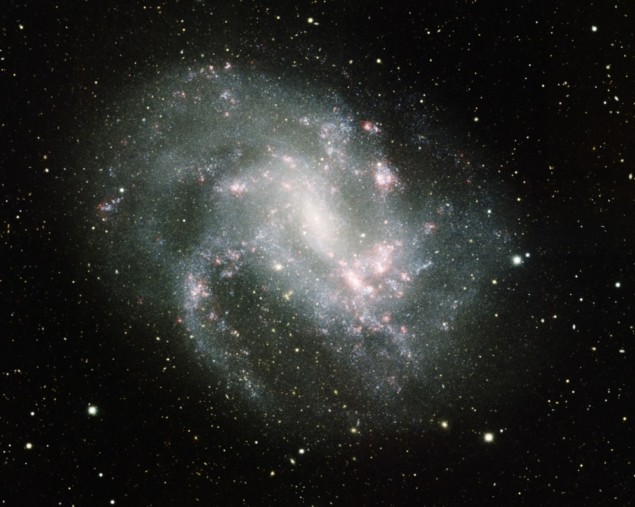
The mass of the smallest black hole known to exist at the centre of an active galaxy has been determined by an international team of astronomers, who argue that their result is “the best direct mass measurement for a galaxy of this size”. The researchers also say that their study could provide important clues about how the most massive black holes form.
The black hole lies 14 million light-years away in the spiral galaxy NGC 4395, which has an active galactic nucleus (AGN) that glows with radiation produced by matter falling into the black hole. NGC 4395 is one of the least luminous active galaxies known. This suggests that its black hole is relatively small compared to most other AGN’s, which can harbour supermassive black holes with masses millions of times that of the Sun.
Previous attempts to measure the mass of the NGC 4395 black hole yielded results ranging from 1000-400,000 solar masses. One reason for the differing results is that the black hole is surrounded in the sky by a large star cluster, and the two cannot be distinguished telescopically.
Cloudy reflections
To try to obtain a more accurate measure of the mass, a research team led by Jong-Hak Woo of Seoul National University in Korea measured how the fluctuations in the luminosity of the accretion disc of material around the black hole reflect off gas clouds much further out. The time delay associated with the reflection is 83 min, which give their distance from the black hole. This is combined with the range, or dispersion, in the velocities of the clouds orbiting the black hole, which is measured to be 426 km/s. Putting all of this together, Woo’s team calculate the black hole’s mass as 10,000 times that of the Sun.
This differs by a factor of 40 with a measurement made in 2018 by an international team led by Mark den Brok, now at the Leibniz-Institut für Astrophysik Potsdam in Germany. Their measurement of 400,000 solar masses was made by trying to optically resolve the centre of NGC 4395.
“Both determinations are heavily dominated by systematic effects,” cautions Michele Cappellari of the UK’s University of Oxford, who was a member of den Brok’s team. “I do not see the difference as too surprising or necessarily invalidating one of the two.”
Bulging correlations
If the mass measurement by Woo’s group is correct, then it is intriguing for a variety of reasons – including how it relates to a general correlation between the mass of a central black hole and the mass and therefore the velocity dispersion of a galaxy’s bulge. This correlation is ubiquitous in more massive galaxies, but even though NGC 4395 does not have a bulge, the correlation appears to have been maintained in the ratio of the mass of the black hole relative to the mass of the central part of NGC 4395.
“It’s surprising to see that the same correlation exists at this very low mass scale,” Woo tells Physics World.
The reason for this correlation is unclear, but a popular explanation is that the black hole and bulge (or the central part of NGC 4395) grow at the same rate. Feedback effects, in the form of an outpouring of radiation from the active black hole, can also play a role in regulating the mass of a galactic bulge by heating and ejecting molecular gas from the centre of the galaxy, curtailing star formation in the process.
In such cases, the active black hole is being fed material that has found its way to the black hole by hierarchical formation – the idea that galaxies grow by absorbing smaller galaxies. However, NGC 4395 displays no evidence of having experienced such mergers, since they would have produced a central bulge in the galaxy around the black hole. Furthermore, although NGC 4395 has an AGN, its activity is so low that it produces minimal feedback. Although Cappellari warns against drawing conclusions from just one object, it could mean that while AGN feedback may still play a role in regulating the mass of larger galaxies, other mechanisms may also be at work.
Light or heavy seeds?
This has implications for how the most massive black holes form. “There are two scenarios suggested for the origin of supermassive black holes,” says Woo. Both begin with the earliest large black holes forming directly from the collapse of a giant gas cloud. Then these early black holes became the seeds for supermassive black holes. In the “light seed” scenario, these first black holes were born with masses 100-1000 times the mass of the Sun. In the alternative “heavy seed” scenario, the black holes were instead born with 10,000-100,000 solar masses.

Astronomers find middleweight black hole
“It is not clear which seed was the origin of NGC 4395’s black hole,” says Woo, “but if the heavy seed model is right, then it means that its black hole has not grown much.”
The lack of black hole growth would be surprising in such a gas-rich galaxy as NGC 4395, says Victor Debattista of the University of Central Lancashire, who is another of den Brok’s collaborators. “This probably implies that the seed black hole was relatively low mass,” he adds, but Woo argues that this is contradicted by the apparent lack of galaxy mergers experienced by NGC 4395, which would have perturbed the orbits of gas clouds to fall into the black hole, while also supplying a diet of intermediate-mass black holes that would merge to form the current black hole.
Instead, says Woo, we may be looking at a primordial relic – a leftover black hole seed that never got the chance to grow into a supermassive black hole.
The research is described in Nature Astronomy.



